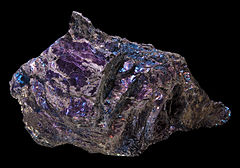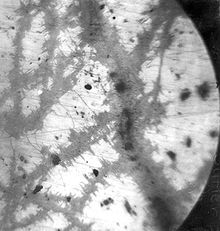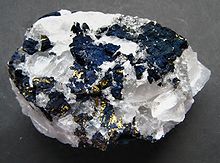- Covellite
-
Covellite 
General Category Sulfide mineral Chemical formula copper sulfide:CuS Strunz classification 02.CA.05a Dana classification 02.08.12.01 Crystal symmetry Hexagonal dihexagonal dipyramidal H–M Symbol (6/m 2/m 2/m) Space group: P 63/mmc Unit cell a = 3.7938 Å, c = 16.341 Å; Z = 6 Identification Color Indigo-blue or darker, commonly highly iridescent, brass-yellow to deep red Crystal habit Thin platy hexagonal crystals and rosettes also massive to granular. Crystal system Hexagonal Cleavage Perfect on {0001} Tenacity Flexible Mohs scale hardness 1.5 - 2 Luster Submetallic, inclining to resinous to dull Streak Lead gray Diaphaneity Opaque Specific gravity 4.6 - 4.8 Optical properties Uniaxial (+) Refractive index nω = 1.450 nε = 2.620 Pleochroism Marked, deep blue to pale blue Fusibility 2.5 Other characteristics Micaceous cleavage References [1][2][3]  Covellite (gray) replacing and embaying chalcopyrite (light), polished section from Horn Silver Mine, San Francisco Mining District, Utah. Enlarged 210 diameters
Covellite (gray) replacing and embaying chalcopyrite (light), polished section from Horn Silver Mine, San Francisco Mining District, Utah. Enlarged 210 diameters
Covellite (also known as covelline) is a rare copper sulfide mineral with the formula CuS. This indigo blue mineral is ubiquitous in copper ores, it is found in limited abundance and is not an important ore of copper itself, although it is well known to mineral collectors.
The mineral is associated with chalcocite in zones of secondary enrichment (supergene) of copper sulfide deposits. Commonly found with and as coatings on chalcocite, chalcopyrite, bornite, enargite, pyrite, and other sulfides, it often occurs as pseudomorphic replacements after other minerals. Despite the very rare occurrence as a volcanic sublimate, the initial description was at Mount Vesuvius by Nicola Covelli (1790–1829).[3]
Contents
Composition
Covellite (CuS) belongs to the binary copper sulfides group, which has the formula CuxSy and can have a wide-ranging copper/sulfur ratio from 1:2 to 2:1 (Cu/S).[4], However this series is by no means a continuous one and the width of the homogeneity range of covellite CuS is narrow. Materials rich in sulfur CuSx where x~ 1.1- 1.2 do exist but they exihibit "superstructures" a modulation of the hexagonal ground plain of the structure spanning a number of adjacent unit cells. This indicates that several of covellite's special properties are the result of molecular structure at this level.[5] Even though the peculiar monovalent nature of copper in sulfides has been known since the 1980s there are many places in the later literature, even in standard texts, where the divalent copper idea pops up again.[4]
As described for the mineral pyrite, the assignment of formal oxidation states (or charges) to the atoms that constitute covellite is deceptive. The formula might seem to suggest the description Cu2+, S2−. In fact the atomic structure shows that copper and sulfur each adopt two different geometries. However photoelectron spectroscopy, magnetic and electrical properties all indicate the absence of Cu2+ (d9) ions. In contrast to the oxide CuO the material is not a magnetic semiconductor but a metallic conductor with weak Pauli-paramagnetism. Thus, the mineral is better described as consisting of Cu+ and S− rather than (Cu2+ and S2−). As happens in the pyrite structure the non-closed shell S− undergoes pairing to form S22−, but interestingly this only holds for 2/3 of the sulfur atoms. The other 1/3 remains unpaired and together with Cu atoms forms hexagonal layers reminiscent of the boron nitride (graphite structure). Thus a description Cu+3S−S22− would seem appropriate with a delocalized hole in the valence band leading to metallic conductivity. Later bandstructure calculations however indicate that the hole is more localized on the sulfur pairs than on the unpaired sulfur. This means that Cu+3S2−S2− with a mixed sulfur oxidation state -2 and -1/2 is more appropriate. There is a precedence for that in the (synthetic) pyrite CuS2 that should also be seen mostly as Cu+S2− producing a Pauli-paramagnetic metallic conductor rather than a semiconductor with strong magnetic properties. (For references see: copper monosulfide).
Formation
Covellite is commonly found as a secondary copper mineral in deposits. It is rarely a primary mineral in copper deposits, and is even less likely to be found as a volcanic sublimate. Covellite is known to form in weathering environments near the surface in deposits where copper is the primary sulfide. As a primary mineral, the formation of covellite is restricted to hydrothermal conditions.
Covellite's unique crystal structure is related to the conditions of its formation. Its distinct framework is produced during oxidative formation conditions. Attempts to synthesize covellite [6][7] indicate it undergoes a complex oxidation process, and that its formation depends on the state and history of the associated sulfides it was derived from. Experimental evidence [6] shows ammonium metavanadate (NH4VO3) to be a potentially important catalyst for covellite's solid state transformation from other copper sulfides.
Geologic occurrence
Covellite's occurrence is widespread in the United States. In Silver Bow County, Montana, covellite has been found in veins at depths of 1,150 meters, as the primary mineral. Covellite formed as clusters in these veins reaching one meter across in Leonard mines, Montana.[8] As a secondary mineral, covellite also forms as descending surface water in the supergene enrichment zone oxidizes and redeposits covellite on hypogene sulfides (pyrite and chalcopyrite). Locally, findings of covellite have been discovered in salt domes[citation needed] and at the McCellan copper mine in Foard County, Texas.[9] An unusual occurrence of covellite was found replacing organic debris in the red beds of New Mexico.[10]
It has also been reported from the Calabona mine, Alghero, Sardinia; at Bor, Serbia; from Leogang, Salzburg, Austria; at Dillenburg, Hesse and Sangerhausen, Saxony, Germany; from Kedabek, Caucasus Mountains, Russia and in the Bou-Skour mine, Bou Azzer district, Morocco.[1]
Applications
Covellite was the first discovered natural superconductor.[11] The framework of CuS3 /CuS2 allow for an electron excess that facilitate superconduction during particular states, with exceptionally low thermal loss. Material science is now aware of several of covellite's favorable properties and several researchers are intent on synthesizing covellite.[12][13] Gramp et al. (2006) discovered that covellite can also be produced in the lab under anaerobic conditions by sulfate reducing bacteria at a variety of temperatures. However, further research remains, because although the abundance of covellite may be high, the growth of its crystal size is actually inhibited by physical constraints of the bacteria.[14] It has been experimentally demonstrated that the presence of ammonium vanadates is important in the solid state transformation of other copper sulfides to covellite crystals.[6]
See also
References
- ^ a b Handbook of Mineralogy
- ^ Webmineral data
- ^ a b Mindat.org
- ^ a b Siew Wei Goh, Alan N. Buckley, Robert N. Lamb (2006). "Copper(II) sulfide?". Minerals Engineering 19 (2): 204–208. doi:10.1016/j.mineng.2005.09.003.
- ^ Putnis, A., Grace, J. and Cameron, W.E. (1977). "Blaubleibender covellite and its relationship to normal covellite". Contributions to Mineralogy and Petrology 60 (2): 209–217. doi:10.1007/BF00372282.
- ^ a b c Simonescu, C.M., Teodorescu, V.S., Carp, O., Patron, L. and Capatina, C. (2007). "Thermal behaviour of CuS (covellite) obtained from copper–thiosulfate system". Journal of Thermal Analysis and Calorimetry 88 (1): 71–76. doi:10.1007/s10973-006-8079-z.
- ^ Ghezelbash A, Korgel BA. (2005). "Nickel sulfide and copper sulfide nanocrystal synthesis and polymorphism". Langmuir 21 (21): 9451–9456. doi:10.1021/la051196p. PMID 16207021.
- ^ Cook, R.B., Covellite: Summitville, Rio Grande County, Colorado. Rocks & Minerals. 296-300. 2006.
- ^ Rocks & Minerals 81:296-300
- ^ Emmons, W. H., The Enrichment of Ore Deposits, Bulletin 625, United States Geological Survey, 1917, p. 193
- ^ Benedetto, F.D., Borgheresi, M., Caneschi, A., Chastanet, G., Cipriani, C., Gatteschi, D., Pratesi, G., Romanelli, M., Sessoli, R. (2006). "First evidence of natural superconductivity". European Journal of Mineralogy 18 (3): 283–287. doi:10.1127/0935-1221/2006/0018-0283.
- ^ Chunyan Wu, Shu-Hong Yu, and Markus Antoniette (2006). "Complex Concaved Cuboctahedrons of Copper Sulfide Crystals with Highly Geometrical Symmetry Created by a Solution Process". Chemistry of Materials 18 (16): 3599–3601. doi:10.1021/cm060956u.
- ^ Nava, Dora, Gonzalez, I et al. (2006). "Electrochemical characterization of chemical species formed during the electrochemical treatment of chalcopyrite in sulfuric acid". Electrochimica Acta 51 (25): 5295–5303. doi:10.1016/j.electacta.2006.02.005.
- ^ Gramp, J.P., Sasaki, K., Bigham, J.M., Karnachuck, O.V., Tuovinen, O.H. (2006). "Formation of Covellite (CuS) Under Biological Sulfate-Reducing Conditions". Geomicrobiology Journal 23 (8): 613–619. doi:10.1080/01490450600964383.
- Dana's Manual of Mineralogy ISBN 0-471-03288-3
Categories:- Copper minerals
- Sulfide minerals
- Hexagonal minerals
Wikimedia Foundation. 2010.

